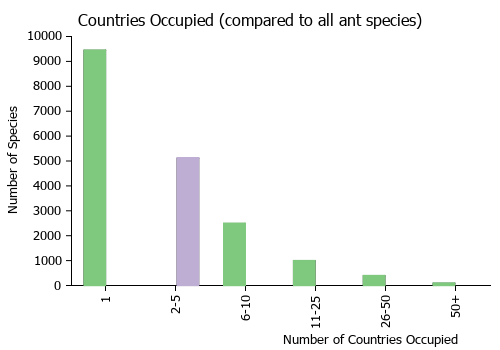Strumigenys datryx
| Strumigenys datryx | |
|---|---|

| |
| Scientific classification | |
| Kingdom: | Animalia |
| Phylum: | Arthropoda |
| Class: | Insecta |
| Order: | Hymenoptera |
| Family: | Formicidae |
| Subfamily: | Myrmicinae |
| Tribe: | Attini |
| Genus: | Strumigenys |
| Species: | S. datryx |
| Binomial name | |
| Strumigenys datryx Bolton, 2000 | |
One of the few known specimens was collected from a litter berlesate sample.
Identification
Bolton (2000) - A member of the smythiesii complex in the Strumigenys godeffroyi-group. See notes under Strumigenys lichiaensis. This minute species is superficially similar to the common and widely distributed Strumigenys rofocala. The latter lacks flagellate hairs on the hind basitarsus and has the base of the apical antennal segment attenuated and narrowly articulated to the preapical antennomere. In datryx a flagellate hair is present on the hind basitarsus and the apical antennal segment is broad basally and broadly articulated to the preapical segment.
Musfira et al. (2022) - Bolton (2000) noted that Strumigenys datryx is superficially similar in the worker morphology to Strumigenys rofocala. The worker of S. datryx can be distinguished from that of S. rofocala by the following characters:
- a flagellate hair present on the hind basitarsus (vs. absent in S. rofocala)
- the apical antennal segment broad basally and broadly articulated to the preapical segment (vs. the base of the apical antennal segment attenuated and narrowly articulated to the preapical antennomere in S. rofocala) (Bolton, 2000).
In the present study, we found clear differences in the queen morphology between S. datryx and S. rofocala (CASENT0104944, paratype, queen):
- in S. datryx, the distance between the lateral ocelli is equal to the distance between the lateral and median ocelli and twice as long as the major axis of the median ocellus (vs. the distance between the lateral ocelli is shorter than the distance between the lateral and median ocelli and four times as long as the major axis of the median ocellus in S. rofocala)
- the lateral surface of the pronotum is partially smooth and shiny (vs. entirely sculptured in S. rofocala)
- the mesonotum and the propodeum are entirely smooth and shiny (vs. generally smooth and shiny, with its dorsolateral part sculptured)
- the mesoscutum is densely covered with erect and appressed hairs (vs. sparsely covered with erect and appressed hairs)
Keys including this Species
Distribution
Distribution based on Regional Taxon Lists
Indo-Australian Region: Indonesia (type locality), Malaysia.
Distribution based on AntMaps
Distribution based on AntWeb specimens
Check data from AntWeb
Countries Occupied
| Number of countries occupied by this species based on AntWiki Regional Taxon Lists. In general, fewer countries occupied indicates a narrower range, while more countries indicates a more widespread species. |

|
Estimated Abundance
| Relative abundance based on number of AntMaps records per species (this species within the purple bar). Fewer records (to the left) indicates a less abundant/encountered species while more records (to the right) indicates more abundant/encountered species. |

|
Biology
|
Castes
Nomenclature
The following information is derived from Barry Bolton's Online Catalogue of the Ants of the World.
- datryx. Strumigenys datryx Bolton, 2000: 806 (w.) INDONESIA (Sumatra).
Unless otherwise noted the text for the remainder of this section is reported from the publication that includes the original description.
Description
Worker
Holotype. TL 1.6, HL 0.43, HW 0.32, CI 74, ML 0.18, MI 42, SL 0.23, SI 72, PW 0.19, AL 0.44. Characters of smythiesii-complex. Apicoscrobal hair flagellate (distal portion of hair easily broken oft). Marginal pilosity anterior to this of quite dense simple hairs that are moderately long and strongly curved anteriorly. Cephalic dorsum reticulate-punctate, with short straight erect hairs present from level of highest point of vertex to occipital margin; hairs arising at about highest point of vertex longer than maximum diameter of eye. Pronotal humeral hair flagellate. Promesonotal dorsum finely punctulate-shagreenate, much less strongly sculptured than dorsum of head. Pronotal dorsum with 1-2, and mesonotum with 2-3 pairs of erect hairs. In holotype all these hairs are short and simple except for posteriormost mesonotal pair, which is flagellate. Some paratypes have 2 mesonotal pairs flagellate and one or two specimens have a pronotal flagellate pair. This suggests that undamaged specimens may have all promesonotal standing hairs flagellate. Dorsum of petiole node and disc of postpetiole smooth, or the petiole with the minutest vestiges of reticulate sculpture. Standing hairs on first gastral tergite fine, at least some of them flagellate or looped apically. Basigastral costulae shorter than disc of postpetiole.
Paratypes. TL 1.6-1.7, HL 0.43-0.44, HW 0.31-0.32, CI 70-74, ML 0.18-0.19, MI 41-43, SL 0.23-0.24, SI 72-77, PW 0.19-0.20, AL 0.44-0.46 (5 measured).
Type Material
Holotype worker, Indonesia: Sumatra, W Sum., Anai V. Nat. Res., 10 km. W Padangpanjan, 250 m., 17.xi.1989, #18 (Lobl, Agosti & Burckhardt) (Musee d'Histoire Naturelle Genève).
Paratypes. 1 worker, Indonesia: Sumatra, Jambi, Mt Kerinci, 3000 m., 12.xi.1989, #13 (Agosti, Lobl & Burckhardt); 4 workers, Sumatra, Sum. Barat, Kotomalintang, Maninjau Lake, 12.vii.1992, SUM 438, 750 m., litter berlesate (Deharveng & Bedos); 6 workers, Sumatra, Kotomalintang, 12.vii.1992, SUM 440, 750 m. (Deharveng & 8edos) (MHNG, The Natural History Museum, Museum of Comparative Zoology).
References
- Bolton, B. 2000. The ant tribe Dacetini. Memoirs of the American Entomological Institute. 65:1-1028. (page 806, worker described)
- Tang, K. L., Guénard, B. 2023. Further additions to the knowledge of Strumigenys (Formicidae: Myrmicinae) within South East Asia, with the descriptions of 20 new species. European Journal of Taxonomy 907, 1–144 (doi:10.5852/ejt.2023.907.2327).
References based on Global Ant Biodiversity Informatics
- Bolton B. 2000. The ant tribe Dacetini. Memoirs of the American Entomological Institute 65: 1-1028.

